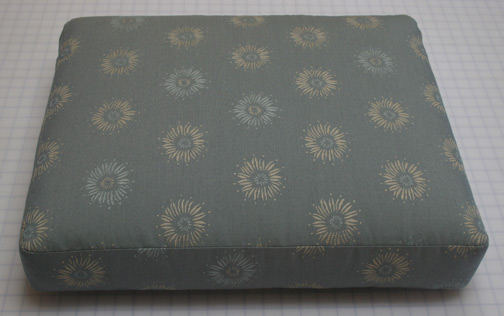These organic cushions were custom made for a unique straw-bale home.



First layer of wool-wrapped latex cushion construction

Wool-wrapped latex cushion construction – second wool layer
See the related video ‘How to Book Wrap your Latex Cushion with Wool Batting’
Join NaturalUpholstery.com’s mailing list to receive our monthly newsletter with reupholstery tips, creative inspiration, and resources for using natural, non-toxic materials for upholstery.
Jill Wagner’s Feb 25, 2014 comment:
Hi Carla,
I corresponded with you a few months ago regarding a couch project I’m working on. We’ve deconstructed a couch and are trying to go as “green” as possible. I plan to use latex foam on the back and seat cushions which leaves us with what to do with the arms?
I would like them to be “slimmish” so not wanting to bulk up too much with foam. Right now they
have a half arched effect made with 1×1 wood slats. We’ve put the strapping and burlap over them but I was wondering about a thick wool felt to protect from that hard sharp edge of the wood that runs on the 45 degree angle.
On top of that maybe just cotton batting? Whatever it is, to keep it thin seems like it needs the thick density of a wool pad. Have you ever come across this. Is that what you are wrapping your seat cushions with? I know you use a supplier in Montana. How thick would you suggest?
I’m in Portland so may be able to find a supplier here of thick wool. Not sure.
Thanks so much. Your blog has been so helpful as I muddle through this.
Jill Wagner
Carla’s response:
Hi Jill,
I’m so glad you’ve found my blog helpful. Here are some tips that might help.
A wool felt layer over the wood, followed by an organic cotton upholstery batting is your best option for padding sharp edges (it compresses down thinner than you might expect – build layers to shape your arms, probably at least 3 layers with extra in particular areas where needed), available at Organic Cotton Plus. Top with organic wool batting – I double the thickness of wool batting in all upholstery applications because of wool’s higher compression rate (doesn’t retain its loft) than the standard .75 oz dacron batting. Depending on what kind of fabric you have, you may want to use a liner on the backside of your fabric with the wool batting to prevent migration of wool fibers through the surface. I use an organic cotton twill from Pickering, and Dharma Trading may have something similar. As tight a weave as you can find is best.
FoamOrder.com and Shepherd’s Dream have wool felt, or you can also use an old wool blanket if you have one, or something similar from a second hand store. You might have to experiment as you build up the layers because the different materials will compress according to their content properties. I have used FoamOrder’s organic wool batting as a top layer in upholstery (to soften the edges), and also to wrap seat cushions.
I’d love to see a photo of your sofa when it’s done – to post on this site. I get a lot of inquiries about alternative materials and I’m working on building a more comprehensive resource for people like you.
I hope this helps – good luck!
Carla
Can I use a coir pad instead of a latex pad? And how to I attach the wool batting? Glue or stitching?
Then do I put a muslin cover on, then get nice covers made to go over? thanks
Hi Erika,
You can use a coir pad, but it won’t have the same resilience as the latex foam (it will feel harder). You may want to pad it with cotton, then wrap with wool batting. You can stitch a muslin cover over the wool, which acts as ticking to keep the wool fibers from migrating through to the cover fabric’s surface, then get a nice cover made to go over it. The important thing to remember if you’re making a cushion to fit in a specific space (as opposed to a stand-alone floor cushion) is to get the correct measurement for the final cushion, then work backward from there. The measurements for your cushion core will vary depending on the materials you use. Most foam cushion cores are made 1/2″ larger than the final cover in order to get a nice snug fit. Your sewing professional (whomever you get to make your covers) should be able to help you with measuring.
Thanks. I will do exactly what you said. Now, when I add the cotton, then the wool. How do i attach each layer. Do I stitch together at edges of material or glue it? Or glue it everywhere?
Without seeing the exact materials you are using, I would say the cotton layer will stick to the coir, and to itself, without any glue or stitching. It may be a challenge to get the clean square edges you would get with foam, but cotton is shape-able. The wool layer will in turn stick well to the cotton without glue, but you’ll want to stitch the final muslin layer around the edges.
Thanks for posting an amazing blog about custom organic window seat cushions. I read your full blog and you explained all the things very well. Furthermore, you gave an amazing example of custom-made cushions.
Once again thanks for the valuable information. Keep posting such types of blogs.